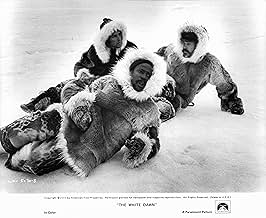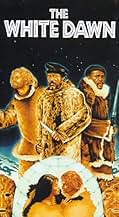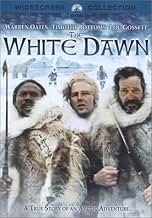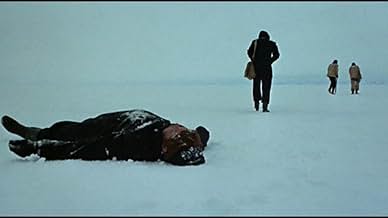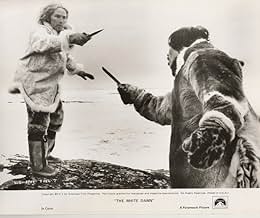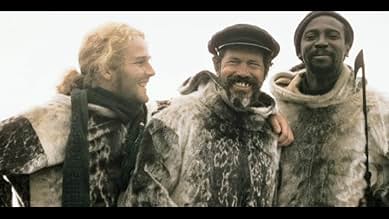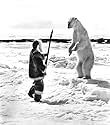IMDb रेटिंग
7.0/10
1 हज़ार
आपकी रेटिंग
अपनी भाषा में प्लॉट जोड़ेंIn 1896, three survivors of a whaling ship-wreck in the Canadian Arctic are saved and adopted by an Eskimo tribe but frictions arise when the three start misbehaving.In 1896, three survivors of a whaling ship-wreck in the Canadian Arctic are saved and adopted by an Eskimo tribe but frictions arise when the three start misbehaving.In 1896, three survivors of a whaling ship-wreck in the Canadian Arctic are saved and adopted by an Eskimo tribe but frictions arise when the three start misbehaving.
Louis Gossett Jr.
- Portagee
- (as Lou Gossett)
Ann Meekitjuk Hanson
- Neevee
- (as Pilitak)
फ़ीचर्ड समीक्षाएं
have some respect for and knowledge of tribal cultures where the shamans have authority, the people are "tuned in" to the natural world, and "nature magic" is understood on a gut level by everyone from childhood onward. I saw this film many years ago and loved it; it's still excellent. If you like it, you may want to read "The Heart of the Hunter" by Laurens Van Der Post, a classic about the Bushmen in South Africa. This film will be of value to anyone who has someone in their family who's made a mess of his or her life because of alcohol. Grab the drinker and make him or her watch it and that person may get a sense for how destructive that behavior is. Anyone who wants to learn about the Bear Spirit will learn something here as well.
It's 1896 in the Artic. Four whalers are stranded when their small hunting boat runs into ice and their ship fails to find them. Billy (Warren Oates), Daggett (Timothy Bottoms), and Portagee (Louis Gossett Jr.) leave behind their dead comrade and get rescued by passing Inuits. The Inuits see them as Dog-Children.
The Inuit culture seems authentic. There is a realism in the people and their way of life. The main drawback is the three survivors. They are not appealing characters. One of them needs to be heroic but the opening already lays bare that aspiration. Daggett and Portagee readily abandons a weaken Billy to die in the open. At least, Daggett should go back and try to comfort Billy. It's the same for their ship which searched for only a day or so for their missing crew. It portrays a western culture of personal greed and its corrupting influences. It doesn't mean that the Inuit culture is an utopian one. It is still very much a human world with its own villain. I simply didn't like the characters which detracts from my enjoyment of this film. I wish I like Daggett more.
The Inuit culture seems authentic. There is a realism in the people and their way of life. The main drawback is the three survivors. They are not appealing characters. One of them needs to be heroic but the opening already lays bare that aspiration. Daggett and Portagee readily abandons a weaken Billy to die in the open. At least, Daggett should go back and try to comfort Billy. It's the same for their ship which searched for only a day or so for their missing crew. It portrays a western culture of personal greed and its corrupting influences. It doesn't mean that the Inuit culture is an utopian one. It is still very much a human world with its own villain. I simply didn't like the characters which detracts from my enjoyment of this film. I wish I like Daggett more.
Philip Kaufman is a filmmaker I find fascinating, but few other people seem to share that enthusiasm (or even know who he is). He made some oddities in the 1960s and 1970s, before having an amazing streak between 1978 and 1988, directing: Invasion of the Body Snatchers (an improvement of a remake), The Wanderers (most underrated coming-of-age movie), The Right Stuff (that one's literally perfect), and then The Unbearable Lightness of Being (very different to the book, but great for different reasons). His '90s output - or at least what I've seen - is interesting, but not as impressive; movies like Henry & Jules and Quills are both boundary-pushing and a bit patience-testing.
Anyway, seeking out something that's obscure even by his standards was always going to be interesting. Enter The White Dawn, which can't really be included as part of his hot streak. It is pretty decent for what it tries to do, but it lacks a certain something. Maybe that's the point. Kaufman operates on a strange level most people don't really click with. Even I've only clicked with his stuff a handful of times. But what a handful!
The White Dawn is about three European (I think) men getting stranded in the Arctic and then rescued by an Eskimo tribe. I liked how there was subtitled language for the tribe; perhaps even more of their dialogue than English dialogue. There was also a level of respect or at least empathy that you don't always get in films of this age, dealing with some kind of cultural divide.
I guess it fell apart a bit narratively and pacing-wise. It's sort of just a slice-of-life film, at a point, and in an odd way. It continues on for a bit and then it ends, and I was fighting the urge to drift out of it. I think it falters in some areas but I appreciated the authenticity and the way it looked at a different culture of people. The authenticity also carried over to the look and feel of the film; it's an effectively chilly one.
Anyway, seeking out something that's obscure even by his standards was always going to be interesting. Enter The White Dawn, which can't really be included as part of his hot streak. It is pretty decent for what it tries to do, but it lacks a certain something. Maybe that's the point. Kaufman operates on a strange level most people don't really click with. Even I've only clicked with his stuff a handful of times. But what a handful!
The White Dawn is about three European (I think) men getting stranded in the Arctic and then rescued by an Eskimo tribe. I liked how there was subtitled language for the tribe; perhaps even more of their dialogue than English dialogue. There was also a level of respect or at least empathy that you don't always get in films of this age, dealing with some kind of cultural divide.
I guess it fell apart a bit narratively and pacing-wise. It's sort of just a slice-of-life film, at a point, and in an odd way. It continues on for a bit and then it ends, and I was fighting the urge to drift out of it. I think it falters in some areas but I appreciated the authenticity and the way it looked at a different culture of people. The authenticity also carried over to the look and feel of the film; it's an effectively chilly one.
Truth told there's something about the movie that doesn't work, something that stops it just short of fulfilling the potential promised by the setting, story, and talent involved. The problem is not that there's little of plot to speak of because this is the kind of movie that actually benefits from thin plotting but still something seems to be missing.
It could be that the movie follows in episodic fashion the life and misadventures of three whalers stranded in Arctic Canada who are saved from certain death by a group of Eskimos but does so without urgency, capturing an evocative snapshot of Eskimo life, perhaps very faithfully, but still in a very Discovery Channel kind of way. Sure, bears and sea otters are slaughtered for food, but it's that, natives trying to survive in their natural habitat the only way they know, not castaways desperately trying to survive in a hostile world the only way they can. We don't see the three fishes out of water struggling to survive, most everything (food, shelter, even women) is provided for them by the friendly Eskimos.
It could be that the movie is designed, conceived, as a mood piece yet is shot in a very generic by-the-numbers way. If Philip Kaufman captures no small amount of awe-inspiring shots of the glacial Canadian landscape where the movie was shot, it's because he had little more to do than point the camera at any direction around him to get them. You can imagine how much more potential someone like Werner Herzog could have milked out of a setting like this. The individual shots are good but the way they're strung together is mundane and workmanlike.
It could be that for a grim and visceral 'man in the wilderness' adventure, WHITE DAWN is really not very grim or visceral. Kaufman doesn't allow a sense of urgency frostbitten danger or impending doom to seep in. When the three whalers make a run for freedom with a stolen Eskimo boat only to find themselves stranded in the ice again, an Eskimo conveniently shows up to lead them back to safety. Misguidedly the emphasis here is on picturesque rather than bleak. Compare how the three whalers are treated by the friendly wife-sharing Eskimos to the gruesome fate that is reserved in the hands of Algonquin Indians for the Catholic missionaries in Bruce Beresford's BLACK ROBE and the difference highlights a lot of what makes WHITE DAWN a mostly lighthearted affair.
Still, not unlike Nicholas Ray's THE SAVAGE INNOCENTS, a lot of the small vignettes that show the whalers cohabiting with the Eskimos are a lot of fun to watch. Chief among the one where Warren Oates cons a man out of his two daughters in a knife-throwing betting contest. But unlike Ray's movie, THE WHITE DAWN hovers plot less, suspended between beautiful scenery and Eskimo customs, for a little too long.
Perhaps it's the combination of all the above reasons that makes WHITE DAWN an interesting watchable movie, one closer to a hit than a miss. Warren Oates as the grizzly scruffy third mate is a pleasure to watch, this is the kind of character he could play with eyes closed and that's pretty much what he does. And then there's the ending, which I won't spoil, that couldn't have come from anywhere else than typically disillusioned 70's American cinema.
It could be that the movie follows in episodic fashion the life and misadventures of three whalers stranded in Arctic Canada who are saved from certain death by a group of Eskimos but does so without urgency, capturing an evocative snapshot of Eskimo life, perhaps very faithfully, but still in a very Discovery Channel kind of way. Sure, bears and sea otters are slaughtered for food, but it's that, natives trying to survive in their natural habitat the only way they know, not castaways desperately trying to survive in a hostile world the only way they can. We don't see the three fishes out of water struggling to survive, most everything (food, shelter, even women) is provided for them by the friendly Eskimos.
It could be that the movie is designed, conceived, as a mood piece yet is shot in a very generic by-the-numbers way. If Philip Kaufman captures no small amount of awe-inspiring shots of the glacial Canadian landscape where the movie was shot, it's because he had little more to do than point the camera at any direction around him to get them. You can imagine how much more potential someone like Werner Herzog could have milked out of a setting like this. The individual shots are good but the way they're strung together is mundane and workmanlike.
It could be that for a grim and visceral 'man in the wilderness' adventure, WHITE DAWN is really not very grim or visceral. Kaufman doesn't allow a sense of urgency frostbitten danger or impending doom to seep in. When the three whalers make a run for freedom with a stolen Eskimo boat only to find themselves stranded in the ice again, an Eskimo conveniently shows up to lead them back to safety. Misguidedly the emphasis here is on picturesque rather than bleak. Compare how the three whalers are treated by the friendly wife-sharing Eskimos to the gruesome fate that is reserved in the hands of Algonquin Indians for the Catholic missionaries in Bruce Beresford's BLACK ROBE and the difference highlights a lot of what makes WHITE DAWN a mostly lighthearted affair.
Still, not unlike Nicholas Ray's THE SAVAGE INNOCENTS, a lot of the small vignettes that show the whalers cohabiting with the Eskimos are a lot of fun to watch. Chief among the one where Warren Oates cons a man out of his two daughters in a knife-throwing betting contest. But unlike Ray's movie, THE WHITE DAWN hovers plot less, suspended between beautiful scenery and Eskimo customs, for a little too long.
Perhaps it's the combination of all the above reasons that makes WHITE DAWN an interesting watchable movie, one closer to a hit than a miss. Warren Oates as the grizzly scruffy third mate is a pleasure to watch, this is the kind of character he could play with eyes closed and that's pretty much what he does. And then there's the ending, which I won't spoil, that couldn't have come from anywhere else than typically disillusioned 70's American cinema.
Looking back from the 21st century, it is obvious that from the moment Columbus set foot in the new world the indigenous peoples of the Americas were doomed. It is equally obvious to a thoughtful viewer from 2005 that a movie made in 1973 about three shipwrecked whalers who are rescued by a band of Inuit and the resulting culture clash is going to end in tragedy. I knew the conclusion of "The White Dawn" as soon as I read two sentences of it's description on Netflix.
But we shouldn't really hold that against it. Because "The White Dawn" is a very good movie and I am shocked that more movie aficionados haven't heard of it. I never did, and I am a fan of Philip Kaufman and Timothy Bottoms and movies of the 70s, and I have an interest in the arctic. This movie seems to have been buried under a rock somewhere, despite fine performances all around, beautiful cinematography and direction, and fascinating subject matter in the Eskimos.
Filmed on location on Baffin Island in what is now Nunavet, the Inuit territory of Northern Canada, "The White Dawn" portrays the story of the three whalers - Timothy Bottoms, Louis Gossett Jr, and Warren Oates as they live with a sympathetic and friendly Inuit band over the course of a year, and how ultimately the interaction of the two world views leads to tragedy. It is based on the novel of the same name by James Houston, who lived with the Inuit for many years and based his novel on stories handed down through the generations of an actual event of 1897. In a fine performance, Bottoms is sensitive and open to the Eskimo way of life, falling in love with the woman Neevee. On the other hand is arrogant and exploitive Oates, who comes to represent the worst of "civilized" man's attitudes towards the Eskimo. He is dramatically counterbalanced by the equally manipulative Inuit Shaman, who pronounces that the whalers are bringing evil to the band of Eskimos.
While the ending might seem preordained, "The White Dawn" is full of texture as it examines the meeting of cultures. And beyond the story itself, it is full of vivid and powerful images of Eskimo life, presented with apparently absolute realism by the amateur (but very good) Inuit cast. The joys and sorrows of the native's communal life are conveyed as they travel and hunt through the seasons. The highlights of the movie include a seal hunt, later a more desperate walrus hunt, and a winter dance in a large igloo, featuring the strange and wonderful throat chanting of two Inuit girls.
A note for animal lovers - according to the commentary track, while seals and walruses were killed in filming, they were only killed if they would have been killed anyway, and the slain animals were completely utilized for food and fur by the Inuit (who do still hunt and rely on seals). The polar bear used in filming was not injured in any way.
If you are a fan of the cinema of the 70s or movies in general, and are willing to accept the grim nature of the story, I highly recommend "The White Dawn". Certainly it should gain a wider audience and not be forgotten.
But we shouldn't really hold that against it. Because "The White Dawn" is a very good movie and I am shocked that more movie aficionados haven't heard of it. I never did, and I am a fan of Philip Kaufman and Timothy Bottoms and movies of the 70s, and I have an interest in the arctic. This movie seems to have been buried under a rock somewhere, despite fine performances all around, beautiful cinematography and direction, and fascinating subject matter in the Eskimos.
Filmed on location on Baffin Island in what is now Nunavet, the Inuit territory of Northern Canada, "The White Dawn" portrays the story of the three whalers - Timothy Bottoms, Louis Gossett Jr, and Warren Oates as they live with a sympathetic and friendly Inuit band over the course of a year, and how ultimately the interaction of the two world views leads to tragedy. It is based on the novel of the same name by James Houston, who lived with the Inuit for many years and based his novel on stories handed down through the generations of an actual event of 1897. In a fine performance, Bottoms is sensitive and open to the Eskimo way of life, falling in love with the woman Neevee. On the other hand is arrogant and exploitive Oates, who comes to represent the worst of "civilized" man's attitudes towards the Eskimo. He is dramatically counterbalanced by the equally manipulative Inuit Shaman, who pronounces that the whalers are bringing evil to the band of Eskimos.
While the ending might seem preordained, "The White Dawn" is full of texture as it examines the meeting of cultures. And beyond the story itself, it is full of vivid and powerful images of Eskimo life, presented with apparently absolute realism by the amateur (but very good) Inuit cast. The joys and sorrows of the native's communal life are conveyed as they travel and hunt through the seasons. The highlights of the movie include a seal hunt, later a more desperate walrus hunt, and a winter dance in a large igloo, featuring the strange and wonderful throat chanting of two Inuit girls.
A note for animal lovers - according to the commentary track, while seals and walruses were killed in filming, they were only killed if they would have been killed anyway, and the slain animals were completely utilized for food and fur by the Inuit (who do still hunt and rely on seals). The polar bear used in filming was not injured in any way.
If you are a fan of the cinema of the 70s or movies in general, and are willing to accept the grim nature of the story, I highly recommend "The White Dawn". Certainly it should gain a wider audience and not be forgotten.
क्या आपको पता है
- ट्रिवियाAccording to producer Irwin Winkler, this movie was the main factor in his decision to invite director Philip Kaufman to direct The Right Stuff (1983). Portions of Henry Mancini's score for this film can be heard in the later film.
- इसके अलावा अन्य वर्जनThe film was originally given an "R" rating from the MPAA due to the nudity which was then edited for the film to receive a "PG" rating.
- कनेक्शनReferenced in Realizing 'The Right Stuff' (2003)
टॉप पसंद
रेटिंग देने के लिए साइन-इन करें और वैयक्तिकृत सुझावों के लिए वॉचलिस्ट करें
- How long is The White Dawn?Alexa द्वारा संचालित
विवरण
बॉक्स ऑफ़िस
- बजट
- $17,00,000(अनुमानित)
इस पेज में योगदान दें
किसी बदलाव का सुझाव दें या अनुपलब्ध कॉन्टेंट जोड़ें

